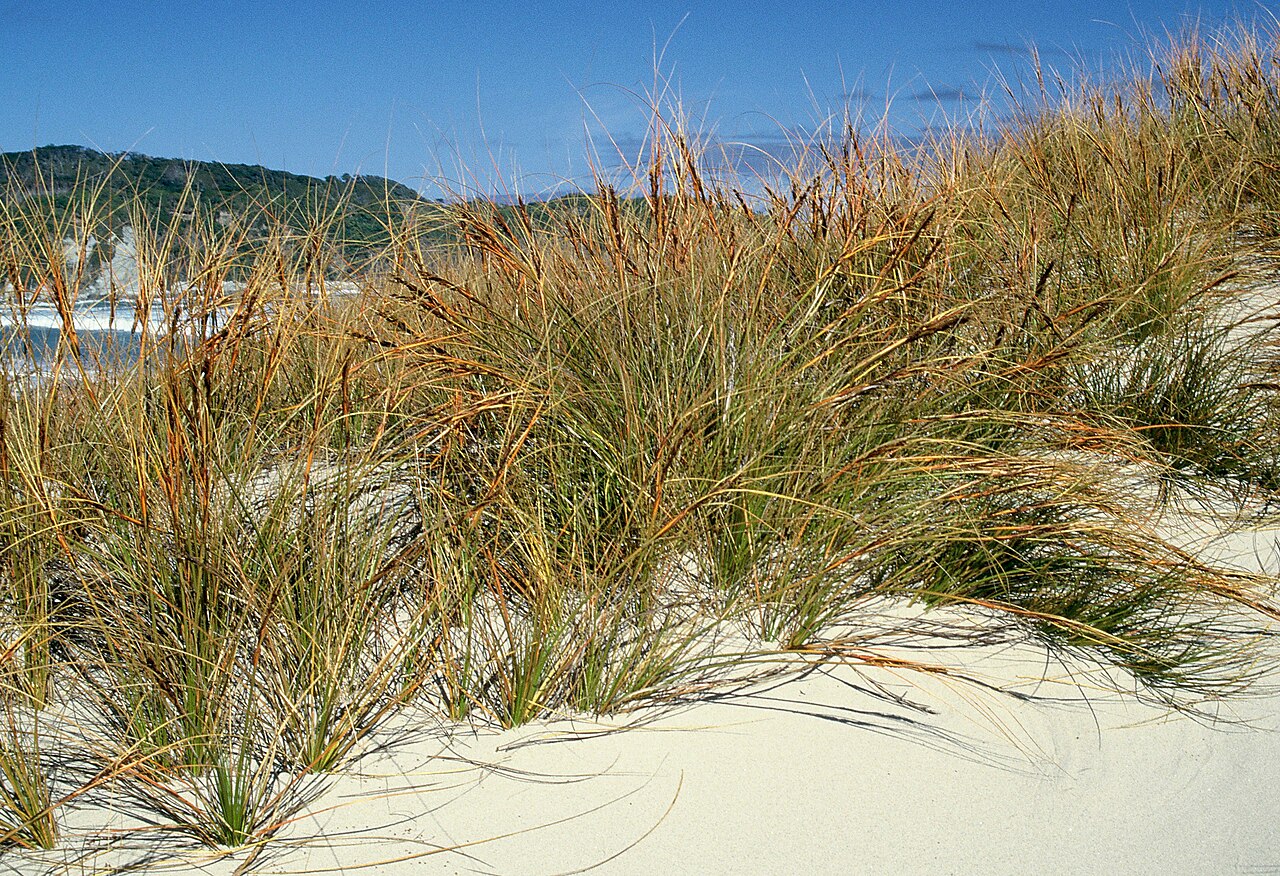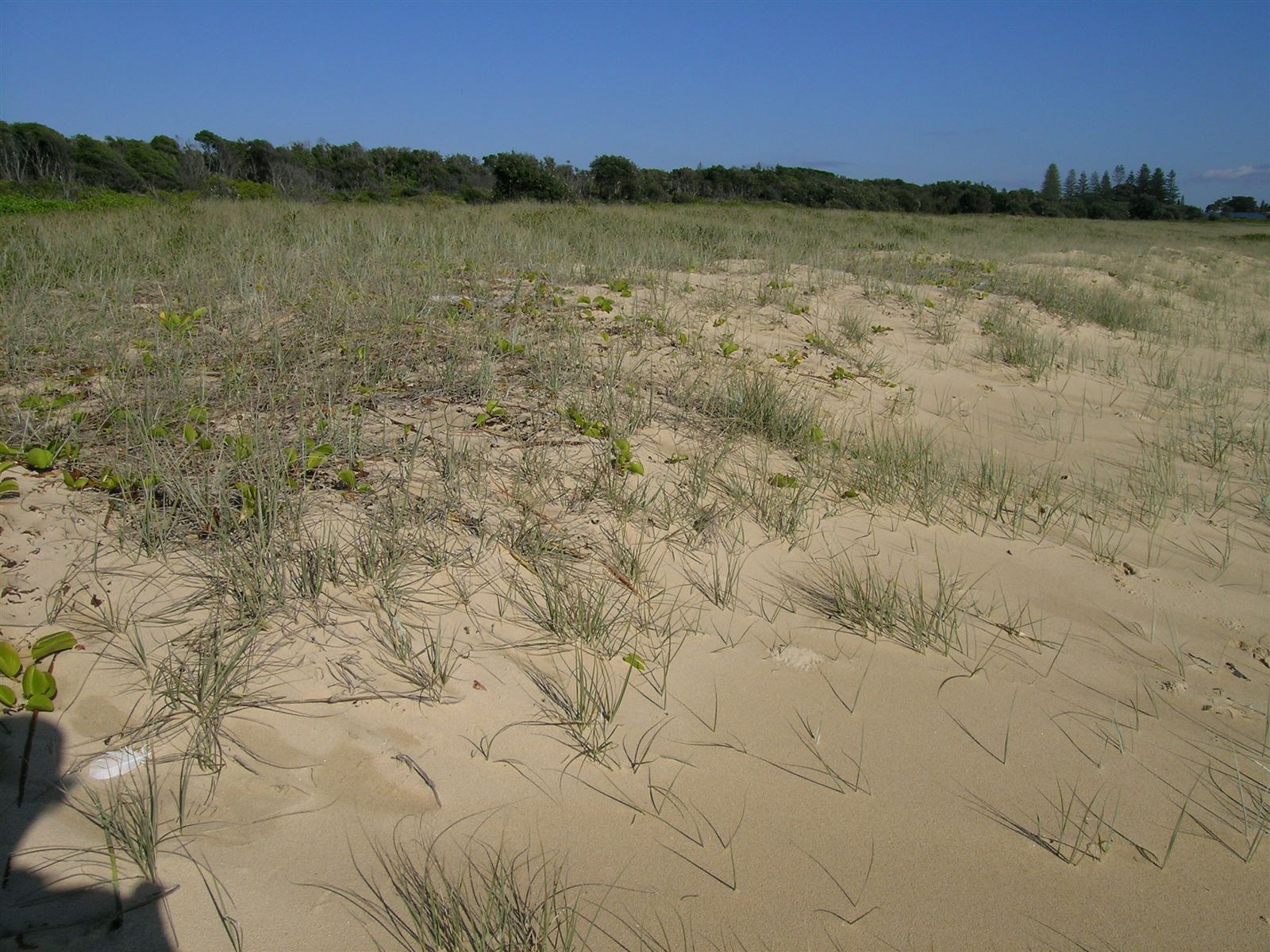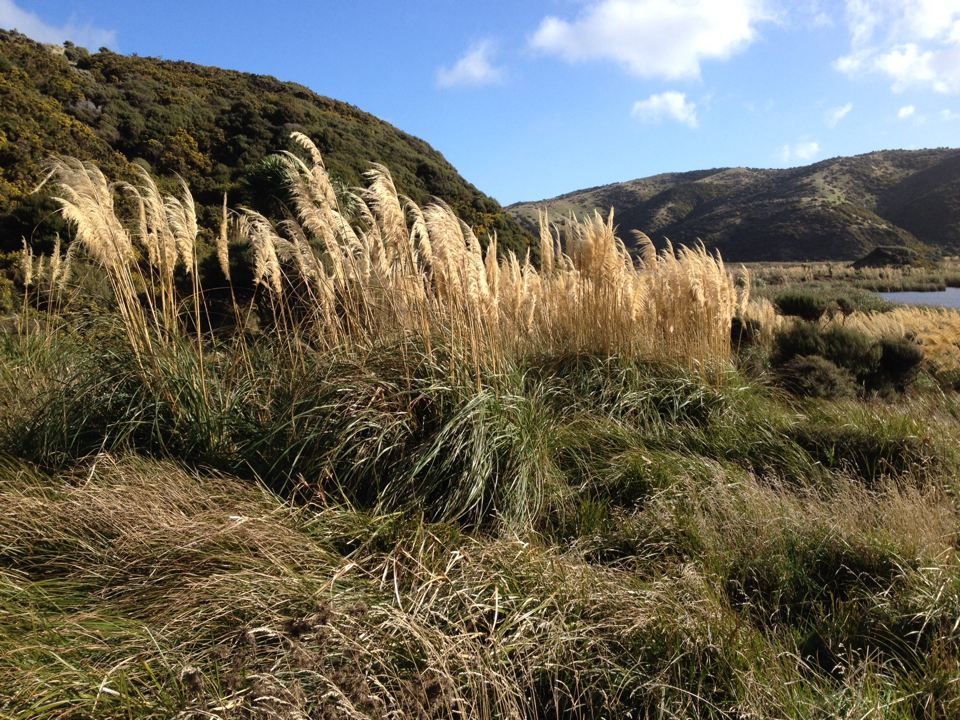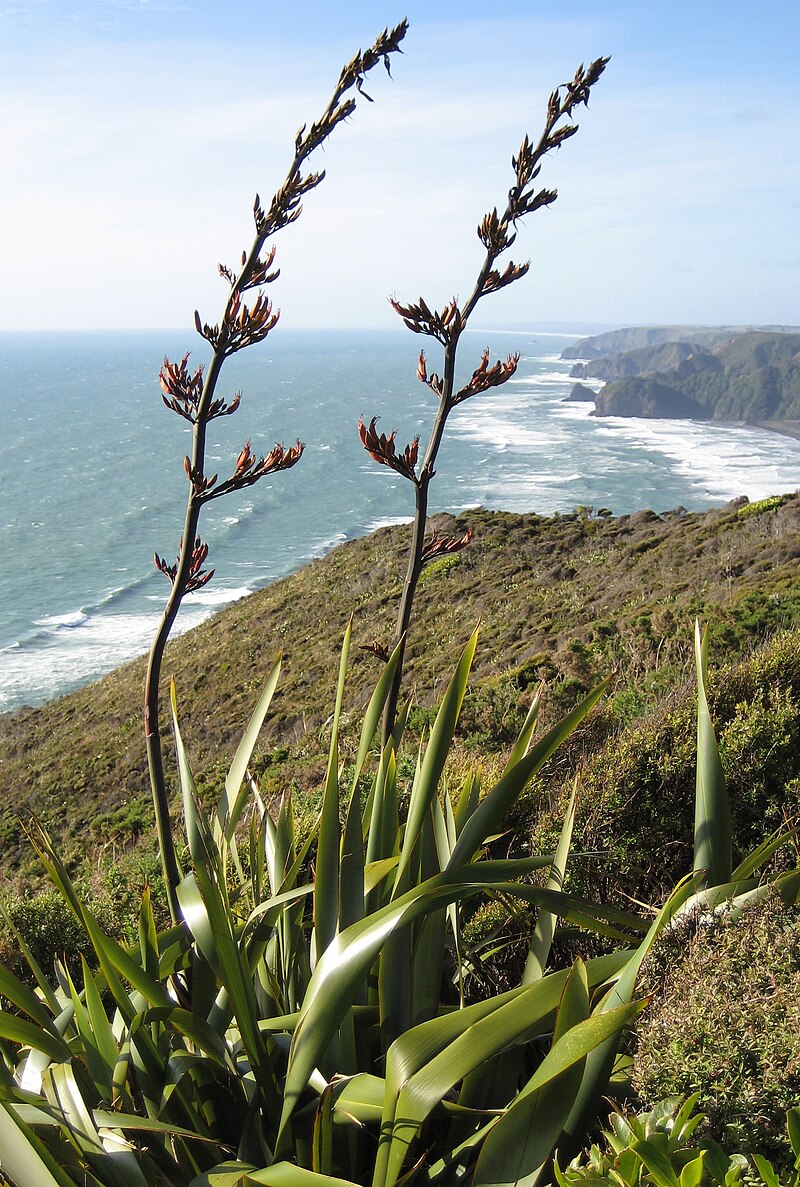Pīngao
Ficinia spiralis
Conservation Status: At Risk - Declining

Image credit: Wikipedia
Pīngao (Ficinia spiralis) is a distinctive golden sand sedge native to New Zealand's coastal dunes. This endemic plant is not only ecologically important for stabilizing sand dunes but also culturally significant for Māori, who have traditionally used its leaves for weaving. With its striking orange-gold color and ability to thrive in harsh coastal environments, pīngao is both beautiful and resilient.
Quick Facts
- Māori names: Pīngao, Pīkao
- Common name: Golden Sand Sedge
- Scientific Name: Ficinia spiralis
- Family: Cyperaceae
- Height: 30-60cm
- Conservation status: At Risk - Declining
- Native Status: Endemic to New Zealand
- Growing Conditions: Full sun, sandy soil
Pīngao (Ficinia spiralis) is a distinctive golden-orange sedge endemic to New Zealand's coastal sand dunes. This remarkable plant plays a crucial role in dune stabilization and has significant cultural importance in traditional Māori weaving, where its vibrant colored leaves create striking patterns in kete (baskets), whāriki (mats), and other treasured items.
Once abundant along New Zealand's coastlines, pīngao has declined significantly due to coastal development, introduced marram grass, and human activities. Today, it is classified as "At Risk - Declining" and is a priority species in dune restoration projects throughout the country.
- Description
- Habitat & Distribution
- Growing & Care
- Uses & Significance
- Gallery
Physical Characteristics
Pīngao is a distinctive coastal sedge with stiff, spirally arranged leaves that grow in dense, rounded clumps. The most striking feature is its golden-orange to yellow-brown color, which is particularly vibrant in the summer months and creates a beautiful contrast against the white sand and blue ocean.
The leaves are tough, 30-60cm long, and curve in a distinctive spiral pattern that gives the plant its scientific name. This spiral growth is an adaptation to the harsh coastal environment, helping to channel water to the plant's base and providing protection from strong winds.
Pīngao produces small, inconspicuous brown flowers on compact spikes that develop into small nutlets. The flowering stems are shorter than the leaves and often hidden within the foliage.

Close-up showing the distinctive spiral arrangement of pīngao leaves
Distinguishing Features
Pīngao can be distinguished from other coastal plants by its:
- Distinctive golden-orange color, especially vibrant in summer
- Spiral growth pattern of the leaves
- Rounded, dense growth form
- Preference for growing directly on mobile sand dunes
It is sometimes confused with introduced marram grass (Ammophila arenaria), but pīngao has wider, flatter leaves with a distinctive color and spiral arrangement, while marram grass has narrower, more upright gray-green leaves.
Seasonal Changes
| Season | Appearance | Notes |
|---|---|---|
| Spring | New growth emerges, leaves become more vibrant | Growth accelerates as temperatures increase |
| Summer | Reaches peak golden-orange coloration | Flowering occurs, typically December to February |
| Autumn | Color may deepen to amber or bronze | Seed development and dispersal |
| Winter | Color may fade slightly, growth slows | Remains evergreen but with reduced vibrancy |
Taxonomy & Classification
Pīngao was previously classified as Desmoschoenus spiralis but has been reclassified to Ficinia spiralis based on genetic studies. It belongs to the Cyperaceae family (sedges) and is endemic to New Zealand, meaning it is found nowhere else in the world naturally.
The genus name Ficinia honors the 19th-century Italian botanist Felice Ficini, while spiralis refers to the distinctive spiral arrangement of the leaves.
Quick Facts
- Native to: Coastal sand dunes throughout New Zealand
- Growth habit: Low-growing sedge with distinctive spiral form
- Height: 30-60cm
- Spread: 50-100cm
- Foliage: Golden-orange, stiff, curved leaves
- Flowers: Inconspicuous brown seed heads
- Best time to plant: Autumn to early spring
- Soil preference: Sandy, free-draining
- Light requirements: Full sun
- Water needs: Low once established
Natural Habitat
Pīngao is a specialized coastal plant that grows primarily on the seaward face of sand dunes, particularly in areas with active sand movement. It thrives in the harsh conditions of the coastal environment, including:
- High exposure to salt spray
- Strong winds
- Shifting sand
- Intense sunlight
- Drought conditions
- Poor nutrient availability
It plays a crucial ecological role in dune formation and stabilization, with its extensive root system helping to bind sand and its above-ground growth catching wind-blown sand to build dunes naturally.

Pīngao in its natural habitat on coastal sand dunes
Distribution in New Zealand
Historically, pīngao was abundant on sand dunes throughout New Zealand's coastline. Today, its distribution has become fragmented and reduced due to coastal development, introduced species, and human activities.
It can still be found in scattered populations around both the North and South Islands, particularly in:
- Northland and Auckland's west coast beaches
- Bay of Plenty
- Waikato and Taranaki coastlines
- Wellington's south coast
- Various locations along the South Island's east and west coasts
- Stewart Island/Rakiura
Many of these remaining populations are now protected and part of active conservation efforts.
Ecological Relationships
Pīngao forms part of a specialized coastal dune ecosystem and has important relationships with other species:
- Dune formation: Works alongside other native sand binders like spinifex (Spinifex sericeus) to create and stabilize dunes
- Habitat provision: Creates sheltered microhabitats for insects, skinks, and other coastal fauna
- Succession: Acts as a pioneer species that helps establish conditions for other coastal plants to grow
Unfortunately, introduced marram grass (Ammophila arenaria) has outcompeted pīngao in many areas, altering dune dynamics and reducing suitable habitat for this native species.
Conservation Status
Pīngao is currently classified as "At Risk - Declining" under the New Zealand Threat Classification System. Its decline is attributed to several factors:
- Coastal development and habitat loss
- Competition from introduced species, particularly marram grass
- Damage from vehicles on beaches and dunes
- Trampling by humans and livestock
- Sand mining and extraction
- Climate change and sea level rise
Numerous conservation initiatives are underway to protect and restore pīngao populations, including dune restoration projects, community planting programs, and the establishment of protected coastal areas.
Growing Conditions
| Factor | Preference | Notes |
|---|---|---|
| Sunlight | Full sun | Requires bright, direct sunlight to develop its characteristic golden color |
| Soil | Sand | Thrives in pure sand with very low organic content; excellent drainage is essential |
| Moisture | Dry to moderate | Drought tolerant once established; sensitive to waterlogging |
| Temperature | Coastal temperate | Hardy to light frost; prefers mild coastal conditions |
| Wind exposure | High | Well adapted to strong winds; actually benefits from some wind exposure |
| Salt tolerance | Very high | Excellent tolerance to salt spray; ideal for coastal gardens |
Planting & Establishment
Pīngao can be challenging to establish but is highly rewarding in the right conditions. Follow these guidelines for successful cultivation:
- When to plant: Autumn to early winter is ideal, allowing roots to establish before summer
- Spacing: Plant 50-75cm apart for dune restoration; can be closer in garden settings
- Planting depth: Set plants at the same level they were in their containers
- Initial care: Water regularly for the first 3-6 months until established
- Mulch: Avoid organic mulches; a light covering of sand is beneficial
For dune restoration projects, it's often planted alongside other native sand binders like spinifex (Spinifex sericeus) and sand tussock (Poa billardierei) for more comprehensive dune stabilization.

Young pīngao plants in a dune restoration project
Ongoing Care
Once established, pīngao is relatively low-maintenance but benefits from:
- Watering: Minimal once established; only during prolonged drought
- Fertilizing: Not required and can be detrimental; pīngao is adapted to low-nutrient conditions
- Pruning: Remove dead or damaged leaves annually; can be cut back to rejuvenate
- Weeding: Regular removal of competing plants, especially introduced grasses
- Protection: Keep foot traffic away from plants, especially in dune settings
In garden settings, occasional light applications of sand around the base of the plant can mimic natural dune conditions and help maintain plant health.
Propagation Methods
Pīngao can be propagated by several methods:
| Method | Success Rate | Notes |
|---|---|---|
| Seed | Moderate | Collect seeds when brown and ripe (late summer to autumn). Sow fresh in a sand/perlite mix. Germination can be slow and irregular, taking 1-3 months. Keep consistently moist until germination. |
| Division | High | Carefully divide established clumps in autumn or early spring. Ensure each division has adequate roots and several healthy shoots. Plant immediately and keep moist until established. |
| Nursery plants | High | The most reliable method for home gardeners. Purchase plants from native plant nurseries specializing in coastal species. Look for healthy plants with good root development. |
For conservation and restoration projects, eco-sourcing (using plant material from local populations) is strongly recommended to maintain genetic diversity and regional adaptations.
Common Problems
While generally robust, pīngao can face several challenges:
- Overwatering: Causes root rot; ensure excellent drainage
- Competition: Particularly vulnerable to being crowded out by introduced grasses
- Physical damage: Sensitive to trampling and vehicle damage
- Rabbits: Can damage young plants; protection may be needed in some areas
- Scale insects: Occasionally affect plants, especially in garden settings
- Inappropriate conditions: Will not thrive in heavy soils or shaded locations
In garden settings, the most common mistake is planting in soil that is too rich or has poor drainage. Pīngao performs best in conditions that mimic its natural coastal habitat.
Regional Suitability

| Region | Suitability | Notes |
|---|---|---|
| Northland | Excellent | Ideal for coastal dunes; historically abundant in this region |
| Auckland | Excellent | Well-suited to west coast beaches; requires full sun and sandy soil |
| Waikato | Good | Suitable for coastal areas only; not for inland planting |
| Bay of Plenty | Excellent | Thrives on coastal dunes; important for restoration projects |
| Gisborne/East Cape | Excellent | Well-adapted to coastal conditions; culturally significant in this region |
| Taranaki | Good | Suitable for coastal dunes; may need protection from extreme weather |
| Manawatu-Whanganui | Good | Grows well on coastal dunes; not suitable for inland gardens |
| Wellington | Good | Suitable for coastal areas; choose sheltered dune locations |
| Nelson/Marlborough | Good | Grows well in sandy coastal areas with full sun |
| West Coast | Good | Suitable for coastal dunes; may struggle with extremely high rainfall |
| Canterbury | Good | Grows well on coastal dunes; not suitable for inland gardens |
| Otago | Challenging | Limited to coastal dunes; may need extra protection in colder areas |
| Southland | Challenging | Found naturally in some areas; requires very specific coastal conditions |
Pīngao is specifically adapted to coastal sand dunes and is not suitable for standard garden conditions. It grows naturally around much of New Zealand's coastline but has become scarce in many areas due to habitat loss and competition from introduced species. For garden use, it should only be planted in coastal properties with sandy soil or in specially created sand gardens that mimic its natural habitat.
Climate Best Suited To
Pīngao is naturally adapted to coastal environments with:
- Temperature: Mild to warm coastal climates (hardiness zones 9-11)
- Rainfall: Tolerant of dry conditions once established
- Wind exposure: High tolerance to salt-laden winds
- Frost tolerance: Low to moderate; can be damaged by hard frosts
This species thrives in the dynamic coastal environment where it experiences salt spray, sand movement, and full exposure to sun and wind. It is not well-suited to inland gardens unless specific coastal conditions can be replicated.
Growing Requirements
Light
Full sun; will not thrive in shade
Water
Low once established; drought-tolerant
Soil
Sandy, free-draining; pH 6.0-8.0
Spacing
50-75cm between plants
Seasonal Care Calendar
Spring
- Plant new specimens in early spring
- Apply slow-release fertilizer if needed
- Remove any competing weeds
- Monitor for pests as growth begins
Summer
- Water newly planted specimens during dry periods
- Continue weed management
- Collect seeds for propagation if desired
- Avoid trampling or disturbing plants
Autumn
- Ideal time for planting
- Remove any dead or damaged foliage
- Apply mulch if in garden setting
- Harvest leaves for weaving (sustainable harvest only)
Winter
- Minimal care required
- Protect from hard frosts if in marginal areas
- Avoid waterlogging
- Plan for spring planting
When to Prune and How Much
Pīngao generally requires minimal pruning. However, some maintenance can help keep plants healthy and attractive:
- Timing: Late autumn to early winter is ideal for any necessary pruning
- Method: Remove only dead, damaged, or diseased leaves by cutting at the base
- Rejuvenation: Older plants can be refreshed by removing older outer leaves
- Caution: Never remove more than one-third of the plant at once
For plants being managed for traditional harvesting, follow cultural protocols and sustainable harvesting practices to ensure plant health and continued growth.
Planting Guide
Site Selection
Choose a location with full sun and sandy, free-draining soil. Ideally on a dune or coastal garden.
Soil Preparation
Ensure soil is sandy and well-draining. If planting in a garden setting, add sand to improve drainage.
Planting
Dig a hole twice the width of the root ball. Plant at the same depth as it was in the container.
Watering
Water thoroughly after planting. Continue to water regularly for the first 3-6 months until established.
Mulching
A light layer of sand can be used as mulch. Avoid organic mulches that retain too much moisture.
Aftercare
Protect from foot traffic and competing weeds while establishing. Minimal fertilizer is needed.
| Best Time to Plant | Spacing | Depth | Time to Establish |
|---|---|---|---|
| Autumn to early spring | 50-75cm | Same as container depth | 6-12 months |
Pests & Diseases
Pīngao is generally resilient to pests and diseases in its natural coastal habitat, but can face some challenges, particularly in garden settings:
| Issue | Symptoms | Treatment |
|---|---|---|
| Scale insects | Small brown bumps on leaves, yellowing foliage | Horticultural oil spray, encourage natural predators |
| Fungal leaf spots | Brown or black spots on leaves, especially in humid conditions | Improve air circulation, avoid overhead watering, fungicide if severe |
| Root rot | Wilting despite adequate water, yellowing, rotting at base | Improve drainage, reduce watering, may need to replant in better-drained soil |
| Rabbit/hare damage | Chewed leaves, especially on young plants | Protective fencing or guards until established |
Prevention: The best approach is preventative—plant in appropriate conditions with good drainage, full sun, and adequate spacing to promote air circulation. In restoration projects, protecting young plants from rabbits and human disturbance is often necessary.
Bonus Tip
Creating a mini dune garden: To successfully grow pīngao away from the coast, create a raised bed with a mix of 80% coarse sand and 20% compost. Shape it into a small dune and plant pīngao on the slopes. This mimics its natural habitat while providing the excellent drainage it requires. For an authentic coastal garden, combine with other native sand dune species like spinifex and sand coprosma.
Cultural Significance
Pīngao holds immense cultural significance for Māori as a treasured weaving material (taonga). Its golden leaves have been used for centuries to create intricate patterns in traditional weaving, where it is particularly valued for:
- Its distinctive golden color that naturally contrasts with the darker kiekie and harakeke
- Its durability and flexibility when properly prepared
- The prestige it brings to completed items due to its relative scarcity
Traditionally, specific pīngao populations were managed by local iwi (tribes), who developed sustainable harvesting practices to ensure the resource remained available for future generations. These practices included harvesting only at certain times of year and leaving enough healthy growth to ensure plant survival.

Traditional kete (basket) incorporating pīngao's golden strands
Traditional Uses
| Use | Description |
|---|---|
| Weaving (raranga) |
The primary traditional use of pīngao was for weaving. The leaves were harvested, dried,
and processed to create various items including:
|
| Dye | The golden color could be extracted to create natural dyes for other weaving materials. |
| Medicinal | Limited medicinal uses included treatments for skin conditions and as a component in some traditional remedies. |
| Ecological knowledge | The presence and health of pīngao served as an indicator of coastal ecosystem health and was incorporated into traditional ecological knowledge systems. |
Modern Applications
Today, pīngao continues to be valued for both traditional and contemporary uses:
- Contemporary Māori art: Remains an important material in modern Māori weaving and mixed-media artwork
- Ecological restoration: A key species in dune restoration projects throughout New Zealand
- Coastal landscaping: Increasingly used in sustainable coastal gardens and public spaces
- Erosion control: Planted to help stabilize coastal areas vulnerable to erosion
- Education: Featured in environmental education programs about coastal ecosystems and Māori cultural practices
The revival of traditional weaving practices has led to increased demand for pīngao, which in turn has supported conservation efforts to protect and restore wild populations.
Conservation Initiatives
Numerous initiatives are underway to protect and restore pīngao populations:
- Community restoration projects: Local groups throughout New Zealand are involved in planting and protecting pīngao on their local beaches
- Iwi-led conservation: Many Māori communities are leading efforts to restore pīngao, combining cultural knowledge with conservation science
- Department of Conservation programs: National initiatives to protect coastal ecosystems include specific focus on pīngao restoration
- Sustainable harvesting guidelines: Development of best practices for weavers to harvest pīngao in ways that ensure plant survival and regeneration
- Research: Ongoing studies into propagation techniques, habitat requirements, and genetic diversity to support conservation efforts
By growing pīngao in your garden or supporting local restoration initiatives, you can contribute to the conservation of this culturally and ecologically important species.
Cultural History
Pīngao has been treasured by Māori for centuries as one of the most important weaving plants. Its cultural significance extends beyond its practical uses:
- Traditional knowledge: The harvesting, preparation, and weaving of pīngao involves specialized knowledge passed down through generations.
- Tribal identity: Different iwi (tribes) developed distinctive patterns and techniques for working with pīngao, which became markers of cultural identity.
- Spiritual significance: The golden color of pīngao is associated with the sun and represents mana (prestige) and status in many traditional items.
- Resource management: Traditional harvesting practices included tikanga (protocols) to ensure sustainable use and protection of pīngao populations.
Today, pīngao continues to be highly valued in contemporary Māori art and craft, with many weavers working to revive traditional techniques and ensure this cultural knowledge continues to future generations.

Pīngao creating a golden carpet on coastal sand dunes

Close-up showing the distinctive spiral growth pattern

Seed heads developing among the golden foliage

Traditional kete (basket) showcasing pīngao's golden color

Young pīngao plants in a community dune restoration project

Pīngao used effectively in a coastal garden design
References & Further Reading
- New Zealand Plant Conservation Network (NZPCN) - Ficinia spiralis
- Department of Conservation (DOC): Coastal Dune Plants of New Zealand
- Te Papa Tongarewa Museum of New Zealand: Māori Weaving Materials
- Bergin, D. (2011). Pīngao: Biology, ecology and guidelines for successful establishment of pīngao. Coastal Restoration Trust of New Zealand
- Te Ara - The Encyclopedia of New Zealand: Story - Coastal plants
- Manaaki Whenua - Landcare Research: Pīngao fact sheet



